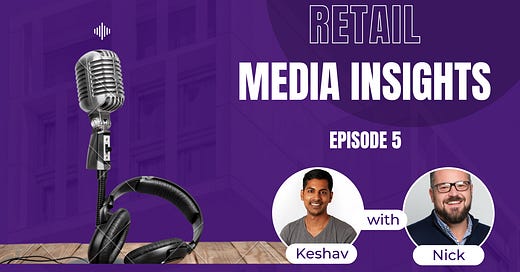My guest for Episode 5 is Nick Henthorn, who is the SVP for Sales in UK and Europe at InfoSum. The contents of this episode are available both as a podcast, and in a condensed and lightly edited written format below.
In this episode, we discuss:
(02:04) Nick's background
(03:23) InfoSum's solutions
(06:16) What is a de-centralised clean room?
(08:03) Case studies of impact
(11:21) Clean room adoption across functions
(13:30) InfoSum's approach to identity solutions
(16:15) InfoSum's measurement solutions
(18:19) Partnership with ITV and Channel4
(20:47) InfoSum’s USP
(23:57) Key considerations when deciding a clean room
(25:41) Common challenges in clean room adoption
____________SLIGHTLY EDITED Q&A VERSION BELOW__________
Q: How did InfoSum start? And what solutions does InfoSum provide as a data clean room?
Nick:
Our business was founded back in 2016 by Nick (another Nick) and it was really founded on the premise that there was just too much data being shared around the marketplace to enable more targeted advertising. Nick then set about building the world's first decentralised data matching solution. The idea is that you can match data sets together without them being commingled in the middle.
And it took Nick and a large development team three years to build a platform, which we launched in 2019 as a data collaboration platform. We took it to the media owners first - like Channel4, who adopted it and made it part of their product suite to then attract advertisers to deliver targeted campaigns without giving their data to Channel4 or vice versa. Then we took it to data partners like Experian. And then more recently, the adoption by the retail media partners. We are now working with shy of a hundred clients who use us for four core things within the advertising space - insights, planning, activation and measurement.
Q: What does it mean to be de-centralised for a clean room?
Nick:
So I'm a bank and I've got my premier customers, and I want to know how many of those premier customers could be identified on a CTV platform. If the route to getting the insight there is that the two data sets, the customer segment and the CTV viewer universe, get matched together at any point, the data has been centralised . And a solution that even temporarily does that to surface an insight, in our view, isn't a decentralised data clean room.
Now, the way we get around that is via our patents, which gives us the ability to effectively run one way queries on a heavily encrypted model. So any query that's run is effectively taking identifiers at a highly pseudonymised state, and then allowing the other partner's bunker, as we call them, to one way test that model. So we're never exposing any of the pseudonymised data from one party to the other to get to the answer.
So pseudonymisation isn't the answer. It's part of our solution to protect our partners. But actually it's the ability to do one way testing which ensures there's never a data transfer between the two of them And there's never a centralisation of data in the middle.
Q: Within organisations that hold a lot of first-party data, such as retailers, there are typically at least two functions that might be interested in using the data clean room. One is the marketing function and the other is the retail media / monetisation function. In your experience, which function typically kicks off the partnership?
Nick:
I'd say typically organisations will go first with what they're best known for. So someone like a Channel 4 started working with us as a media owner. Now we work with them as a brand/marketeer. Our relationship with Tesco Dunhumby started out very much from a retail media perspective, but they also run brand activity. Boots on the other hand, started out as a brand and now working as a media owner. One of our major retail media partners in Europe actually started out with us as a brand/marketeer.
It all depends on where they are as an organisation in terms of their maturity and their retail media propositions. At the end of the day, we deliver value to both and, and our commercial structures allow them to do both things with us. Without having to, invest more into us.
Q: InfoSum does not have its identity solution, but you allow clients to use various identity solutions that are out there in the market today. How commonly clients use an identity partner to improve match rates and which are the more commonly used identity partners.
Nick:
We don't have an identity solution because we are not an owner of data. We're the infrastructure that enables the match between multiple parties. One of our key differentiators is the ease with which you can work on a multi-party query. If you're working bilaterally with another partner, you can utilise more than one identity (e.g., names, emails) to try and create a match. If both parties have multiple versions of me, multiple emails associated or other identities, then the platform will seek to find the match between me and me in different bunkers based on those multiple identities.
You're absolutely right. We do provide a facility to bridge identity. Within our UI, you can just drop in the identity partner (if you've got permission to work with them) and they can bridge identity. One of the real advantages of that approach is that you get to see what the increment is in match rate. Say a brand and a media owner working together get a match rate of 12% using our platform. Then they drop an identity partner and the match rate goes up to 17%. It is clear what the increment is.
Identity bridge is adopted in some of the markets and it tends to be the markets where it's a lot easier to have a great big identity spine in play - for example America. So we work multiple identity partners in the US. Within the European markets we do have partners who have got identity, but we know from organisations who focus on identity that it is getting smaller and smaller. And the reality is that's really down to the fact that you've got to have absolute confidence in the provenance of your data in the first place to be able to offer that service to market. So the likes of the telcos where they've got permission, we do work with them as they can offer identity bridging. But the scale of that consented universe might be limited to deliver much value. In reality, in Europe, what we're seeing is that email is becoming the identity that people are choosing as their primary match and our platform then enables match between two datasets using email as the primary identity.
Q: Does InfoSum provide pre-built measurement models? Or is it mostly for users to run their own queries/models on your platform?
Nick:
Right now our platform is underpinned by a slightly limited version (because of privacy protection) of SQL logic. We have control versus exposed measurement pre-built in the platform, which users can use with a simple drag and drop interface. And whilst the results are fantastic, we do have more and more clients wanting to be able to do more advanced analytics on the relationship between exposed, controlled and outcome.
Going really into some of the detail that frankly our platform hasn't got the capability to deliver. And that's purely down to the fact that it's SQL based as opposed to a more advanced data science platform. But we are evolving our platform and we'll be shortly launching something rather exciting that will help organisations plug in their own data science applications to enable much deeper analytics.
Q: Could you tell us a bit more about your unique partnership with UK’s two big CTV channels - Channel4, and ITV?
Nick:
We've been partner with Channel4 since 2019 when they went out to seek a matching engine that could allow them to match to brand data to deliver a product in the realms of a Sky Adsmart type proposition. They went through a formal process to identify a partner and decided to work with InfoSum. What's really interesting is what they then did and what we've seen other media partners do - create a product. They created a product called Brandmatch, which they offer to their agencies and brands to enable them to do far more intelligent things by bringing their first party data to play. We're the ‘powered by’ bit. We're the intel inside. We're enabling them to do that in a privacy safe way. And, soon after, we saw ITV take a similar approach. ITV have got ITV match and matchmaker. They are products that are effectively powered by InfoSum. We sit there as the connective tissue between Channel4/ITV and the brands, and we work very closely with them to support them when they want to bring new brands up.
Q: Assume a retail media solution is already working with another data clean room provider. If they want to collaborate on an offsite campaign with Channel4/ITV, would they need to establish a partnership with InfoSum additionally?
Nick:
We've had this before. We're the only solution. Partners can utilise another clean room for lots of activities and then just have us as a bolt on where they directly feed data into our platform (instead of the data coming from another clean room) if they want to activate on those CTV channels. So yes, they will need to form a partnership with us for those channels.
Q: There are a few clean room providers. What are InfoSum’s points of difference?
Nick:
It's a really hard one to answer cause everyone positions in different ways and there's lots of organisations who've now put their hands up to say they are clean rooms. And naturally we've got the tech vendors coming into place with their clean room offerings.
There are a few things you can really look out for. And one is a theme we've talked about already today, which is decentralised. Then there are different categories of clean rooms. There's the the pure play clean rooms - like ourselves. There's then the tech vendors. There's arguably what you'd call the centralised clean rooms where you give them data and they they bring it together. And then you've got this other breed, which is the UI layers that sit across other clean rooms. It does make for four very distinct categories there - pure play, tech, centralised, and then UI/enablement. So it's not easy for a potential client to look at them and understand the differences. The only thing I can say is engage the organisations, talk to them all individually.
If you look at our position, we tick the box as decentralised. We are privacy by design. We built this in 2016 with privacy preserving in mind. So we've got that from the ground up, which actually includes things like we're error proof. I don't mean that we never get a bug, right? Because every platform had a bug at some point. Error proof means that someone couldn't have a bad day like write a wrong script and unearth personal data. And it's those sorts of questions that the organisations should ask the clean room partners they are engaging. Is it privacy by design, or is it reverse engineered on top of something else? And they should really get into the weeds on what the process is. We'll always be exceptionally clear in our sales and legal collateral on what's happening underneath the hood of InfoSum. So organisations can be at comfort with what's going on. So ask those same questions of the other partners.
I think the last thing as a differentiator is the marketplace itself. So as I touched on earlier, we've been doing this since 2019 under the guise of collaboration platform And that means that we've got scaled partners across Europe, US and now Asia Pacific. It means that if you're a brand and you want to do something with us, you can join day one and there's partners there you can derive value from. You're not having to go out and find a partner and get them onto a clean room too. The path to value is much faster because of that ecosystem.
Q: What are the top five factors that retailers should consider when deciding a clean room?
Nick:
So centralisation / decentralisation is critical.
I guess permissions comes into this really quite strongly as well. So what controls do you have in place to ensure that your valuable data is only being, even at an aggregate level, accessed by people you want it to be accessed by. If CPG’s want to collaborate with a retailer, then the retailer should be in absolute control of deciding which ones they want to collaborate with and to what value.
The other thing you'd really want to consider is how future proofed is that solution? We've talked quite a lot already about email and we talked about the future of matching. Does the solution you're looking at focus on cookies still for matching, in a world where those cookies are going away? Is it prepared for a world of the cookie less future?
We've already talked about the marriage of CTV and, and retail. Does the clean room have established CTV relationships in the desired geography?
So as a retailer, I would be looking not just at the technology and it's privacy preserving elements and its control preserving elements, but also the ecosystem the vendor has.
Q: What are the common challenges you hear from retail media companies and brands when it comes to clean room adoption?
Nick:
The first area of challenge would really be around the maturity retailers have with their own first party data strategy. If you're looking at a clean room as a retailer, first things first, you need to make sure that you've got your consents in place, or at least a strategy to have consents in place with your consumers. There's no point going into a world of buying technologies to enable offsite media if you haven't got that trusted relationship with your customer already. And as part of that privacy based consideration, it's also making sure that they have thought about the legal ramifications of working with, for example, a CTV partner. They will have to have paperwork between the two of them.
Scale is really important as well. When we look at the first party data strategy, retailers need to have captured a substantial enough scale of first party data for it to be valuable to the CPGs. Is a target customer segment of soft drink buyers with 10,000 people going to be valuable enough for Coke?
Continuing on the theme of first party data strategy, there is still this element that it just feels harder than using cookies. Because it is - you are having to adopt a new technology and having to adopt a new methodology around how you work. And I think organisations overcoming that mental barrier is a challenge in itself. It's obviously, as we've proven, a challenge well worth taking on.
On a wider basis, they need to think about the value as well - how much is it worth? Because putting a number on it by engaging the market will help them obviously build their teams to succeed because teams are critical. Without that fantastic team there, you've got a retailer. To really transition to a retail media proposition and have a clean room for offsite, you need that maturity within your organisational structure, and that's a challenge in itself. At the end of the day, you're asking a retailer who works on fairly small margins to invest into lots of help they haven't currently got. The only way you can get to that investment is by proving the value, which is why one of the challenges is we don't know how much it'll be worth until we do it. But, it's that classic chicken and egg scenario, which actually they can overcome by engaging the market - by talking to CPGs, by talking to media owners to understand what value they in collaboration could have together and help build that case to build that expertise.
And then the final piece for me is just confusion around what each clean room does, how it works and which one's right for them. The only way forward there is for an organisation to engage each of the clean room providers and ask questions to really dig into how it works. Ask for client testimonials.
Finally, when retailers formalise agreements with a media partner, who controls the process - who owns the ability to run queries, who leads on the sale etc. Is it going to be the media owner? Is it going to be the retailer? We see these sort of power struggles within those relations and actually they both want to own it, but one of them has to. Each market is different on that front. We're seeing it certainly in the UK that it is more the media owners who are taking the lead in terms of selling these opportunities to the market. Whereas in Europe, we're seeing it's actually more the retailers.








Share this post